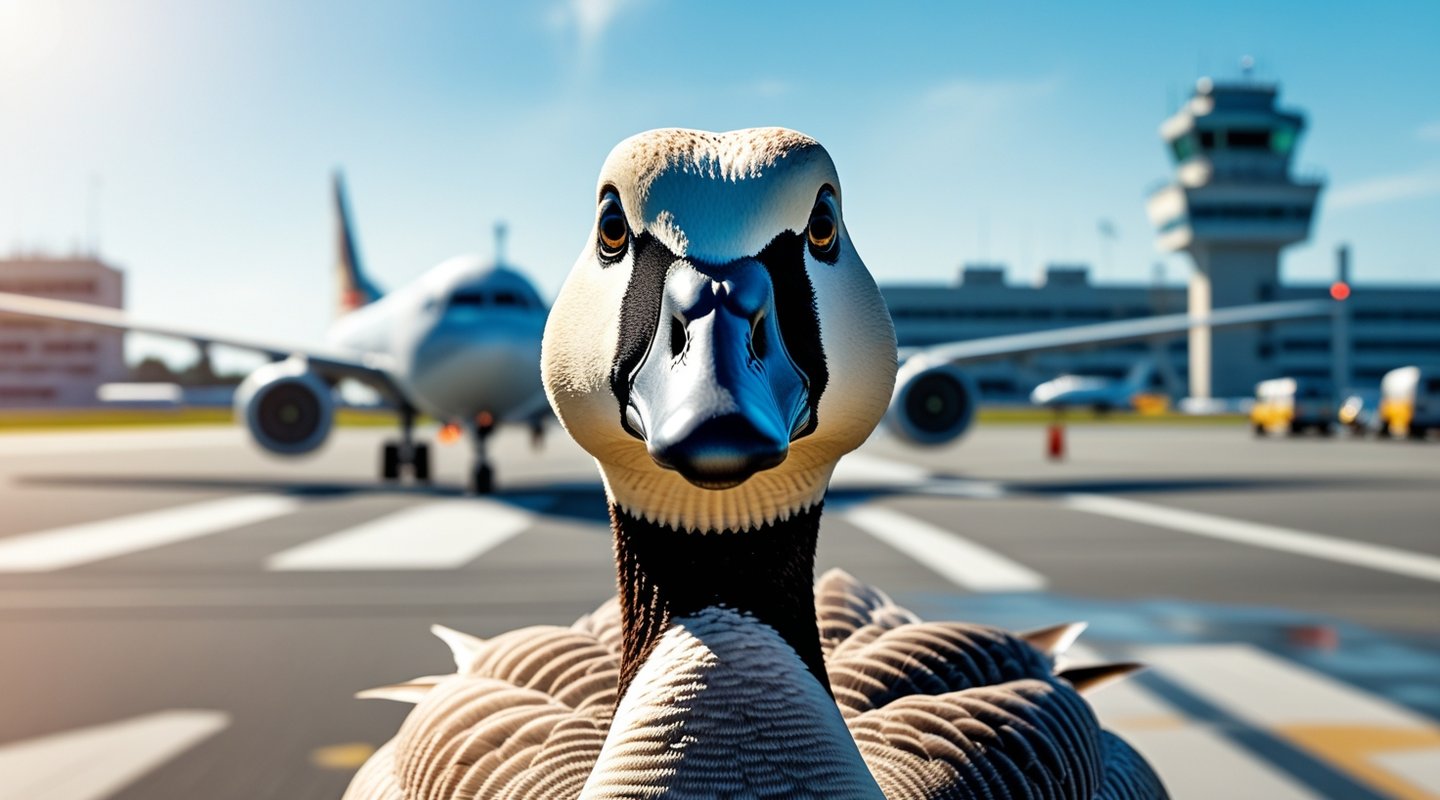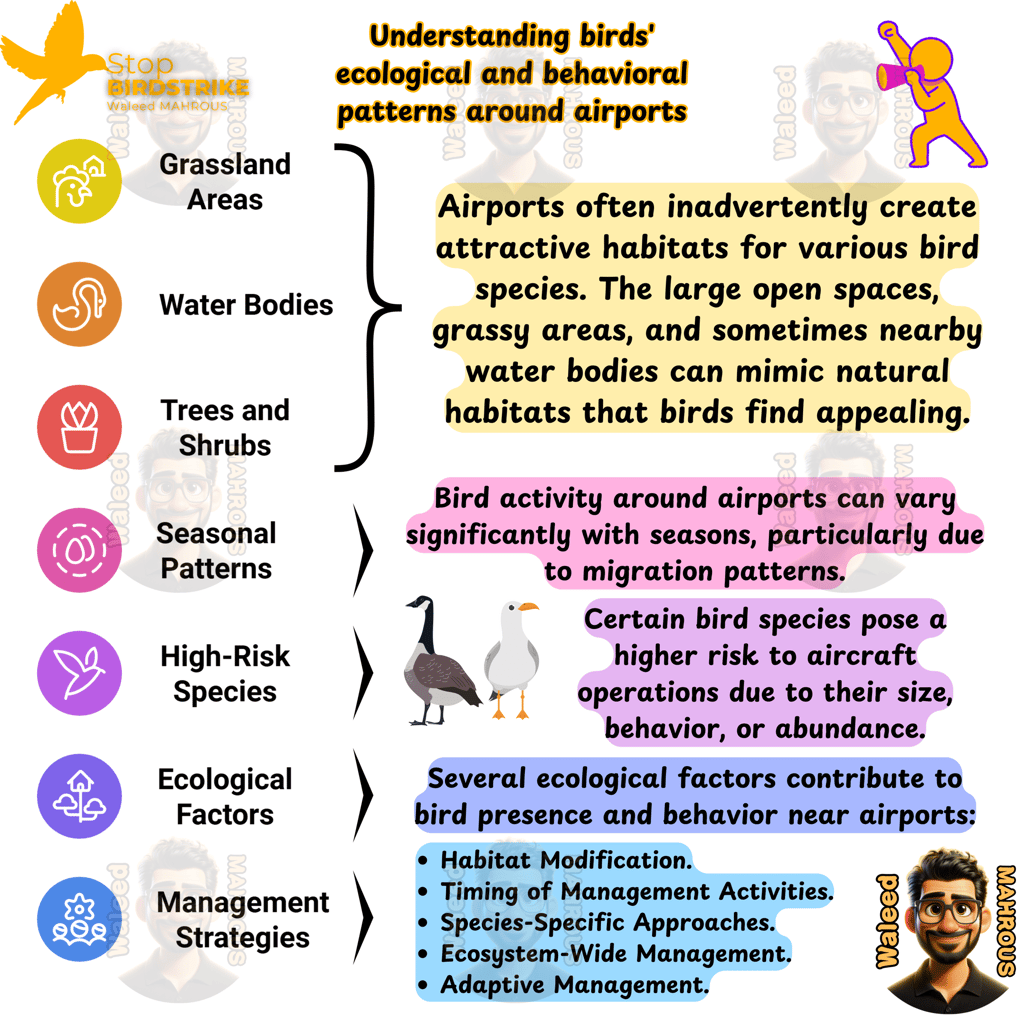Fundamentals of Bird Behavior and Ecology Near Airports
This article dives into the ecological and behavioral patterns that shape bird activity around airports. By understanding why certain areas attract specific bird species and how birds respond to various stimuli, aerodrome managers and wildlife specialists can develop more targeted and sustainable hazard management strategies.
FUNDAMENTALS OF WILDLIFE HAZARD MANAGEMENT
Waleed MAHROUS
1/2/20254 min read


Understanding birds' ecological and behavioral patterns around airports is crucial for developing effective wildlife hazard management strategies. This comprehensive article dives into the factors that influence bird activity near aerodromes, providing insights that can help aerodrome managers and wildlife specialists create more targeted and sustainable approaches to mitigating bird-related risks.
Habitat Attraction
Airports often inadvertently create attractive habitats for various bird species. The large open spaces, grassy areas, and sometimes nearby water bodies can mimic natural habitats that birds find appealing.
Grassland Areas
Short grassland areas, typically maintained at 30 cm or less, are particularly attractive to many bird species. These areas can account for a significant portion of bird abundance at airports, consistently being the most utilized habitat across seasons. The reasons for this preference include:
Foraging opportunities: Short grass exposes insects and small invertebrates, providing an easy food source for many bird species.
Visibility: Open areas allow birds to spot potential predators easily, increasing their sense of security.
Social behavior: Some species, like gulls, prefer open areas for loafing and social interactions.
Water Bodies
Airports located near coastal areas or with standing water on-site often experience higher levels of bird activity. Even small pools of water on uneven pavements can attract birds. Water sources are attractive because they provide:
Drinking water.
Bathing opportunities.
Habitat for aquatic prey species.
Trees and Shrubs
While many airports try to minimize vegetation, any trees or shrubs present can serve as:
Nesting sites.
Roosting areas.
Food sources (fruits, berries, or insects living on the vegetation).
Seasonal Patterns and Migration
Bird activity around airports can vary significantly with seasons, particularly due to migration patterns. Airports located along major migratory routes may experience seasonal spikes in bird activity. Understanding these patterns is crucial for implementing timely and effective management strategies.
Spring and Fall Migration
During these periods, airports may see:
Increased diversity of bird species.
Larger flocks passing through the area.
Changes in local bird behavior as they prepare for or recover from long-distance flights.
Breeding Season
The spring and early summer breeding season can lead to:
Increased nesting attempts on airport grounds.
More frequent foraging trips as birds feed their young.
Presence of inexperienced juvenile birds later in the season.
Behavioral Adaptations to Airport Environments
Birds living near airports have shown remarkable adaptations to the unique challenges posed by these environments.
Acoustic Adaptations
One of the most significant challenges for birds near airports is the intense noise pollution. Research has shown that birds living near airports have developed strategies to cope with this:
Advancing Dawn Chorus: Birds near major airports have been observed to advance their dawn singing time, reducing overlap with periods of intense aircraft noise. This adaptation is particularly pronounced in species that typically sing later in the morning, as they would otherwise overlap more with peak aircraft activity.
Song Modifications: Some birds may alter the pitch or volume of their songs to be heard over the ambient noise, although this strategy has limitations in extremely loud environments.
Foraging Behavior
The presence of aircraft and other human activities can influence when and how birds forage:
Temporal Shifts: Birds may adjust their feeding times to periods of lower aircraft activity.
Spatial Adaptations: Some species may learn to avoid areas with the highest disturbance levels, concentrating their foraging in quieter zones of the airport.
Specific High-Risk Species
Certain bird species pose a higher risk to aircraft operations due to their size, behavior, or abundance (as explained in the previous article). Understanding the ecology of these species is crucial for targeted management:
Gulls
Gulls are often a significant concern at airports because:
They are attracted to large, open paved areas for loafing.
Many gull species are opportunistic feeders, taking advantage of various food sources around airports.
They often form large flocks, increasing the risk of multiple bird strikes.
Raptors
Birds of prey, such as hawks and eagles, can be particularly hazardous due to their size. They are attracted to airports because:
Open grasslands provide good hunting grounds for small mammals.
Tall structures (e.g., light poles, signs) serve as excellent perches for spotting prey.
Waterfowl
Geese and ducks can cause severe damage if struck by aircraft. They are often attracted to:
Grassy areas for grazing.
Water bodies on or near airport property.
Ecological Factors Influencing Bird Presence
Several ecological factors contribute to bird presence and behavior near airports:
Food Availability
The type and abundance of food sources significantly influence bird activity:
Insect populations in grassy areas.
Small mammals in open fields.
Waste from human activities (e.g., improperly managed food waste).
Nesting and Roosting Sites
The availability of suitable nesting and roosting sites can lead to persistent bird presence:
Buildings and structures that mimic cliff faces (for species like pigeons).
Trees and shrubs for perching and nesting.
Open water for waterfowl.
Local Ecosystem Interactions
The broader ecosystem surrounding an airport plays a crucial role:
Nearby farms can attract birds, not just those focused on plant agriculture.
Urban development patterns can influence bird movement and habitat use.
Natural areas (e.g., wetlands, forests) in the vicinity can serve as source populations for birds entering airport spaces.
Implications for Wildlife Hazard Management
Understanding these fundamental aspects of bird behavior and ecology near airports has significant implications for developing effective management strategies:
Habitat Modification: Tailoring the airport environment to be less attractive to high-risk species, such as managing grass height or removing standing water.
Timing of Management Activities: Aligning wildlife control efforts with periods of peak bird activity, which may vary by species and season.
Species-Specific Approaches: Developing targeted strategies for the most problematic species based on their specific behavioral and ecological traits.
Ecosystem-Wide Management: Considering the broader landscape and working with surrounding landowners to manage attractants beyond airport boundaries.
Adaptive Management: Continuously monitoring bird activity and adapting strategies based on observed changes in behavior or population dynamics.
By integrating this deep understanding of bird behavior and ecology into wildlife hazard management plans, airports can develop more effective, sustainable, and environmentally responsible approaches to reducing bird strike risks. This knowledge-based approach not only enhances aviation safety but also promotes coexistence between human activities and local wildlife populations.
References:
https://behavecol.es/en/research/birds-advance-their-dawn-chorus-near-airports~32
https://digitalcommons.unl.edu/cgi/viewcontent.cgi?article=1458&context=icwdm_usdanwrc
https://academic.oup.com/beheco/article-abstract/26/2/435/257883?redirectedFrom=fulltext&login=false
https://www.robinradar.com/resources/airport-bird-control-guide
https://aeriumanalytics.com/top-3-challenges-with-wildlife-mitigation-at-airports/
https://academic.oup.com/beheco/article-abstract/26/2/435/257883?redirectedFrom=PDF&login=false
https://www.nbcenvironment.co.uk/your-industry/airport-bird-control/
https://www.pestmanglobal.com/solution/airport-bird-control-methods/



